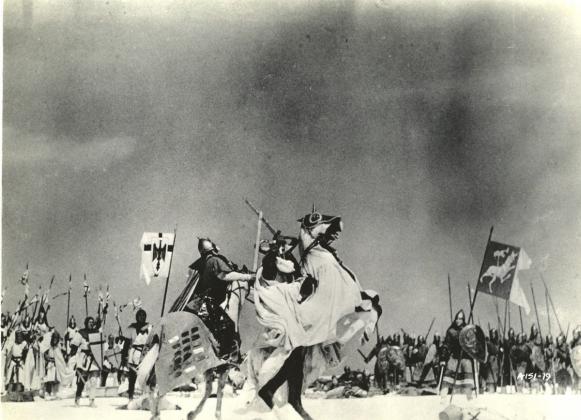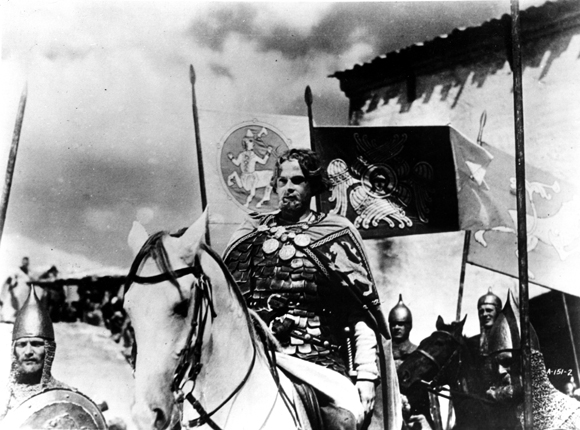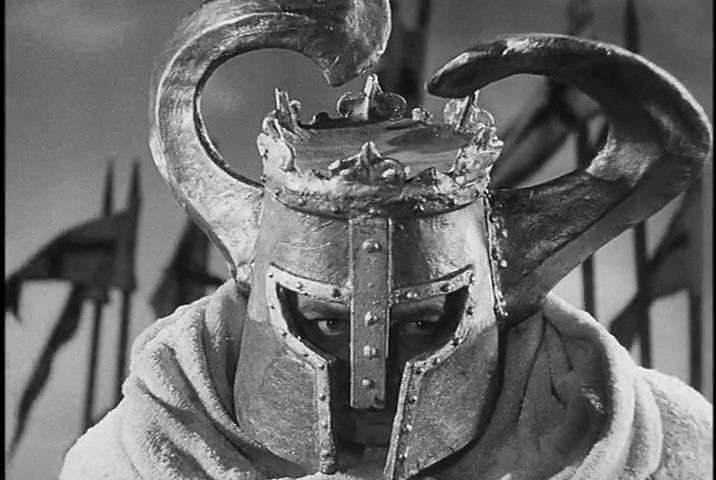Medieval combat, “The Battle on the Ice,” music by Prokofiev and the Soviet master of montage (editing) makes a spectacle out of mise en scene (production design, epic shot compositions) — that’s what cinephiles summon up when revering Serge Eisenstein’s 1938 classic “Alexander Nevsky.”
A filmmaker famed for telling his stories and making his (often propagandistic) points with masterful flurries of edits in “Battleship Potemkin” and “October” turns stately and almost grandiose with a large-scale patriotic epic taken from the pages of Russian history.
What sticks in the memory — and it’s been decades since I first saw it — is that famous set-piece, “The Battle on the Ice,” a sweeping scrum of cavalry and infantry set on a frozen lake, action-packed but seen largely through the eyes of a handful of stock character “types” caught up in it.
Watching “Nevsky” again, I can’t help but be struck by how Western it looks, as in The Old West as it was filmed by John Ford. “Stage Coach,” which Ford released a year later, has traces of “Nevsky” that must have been most obvious when seeing them new, in cinemas just a year apart.
They’re totally different movies, but their story structure, character tropes and set pieces are shot and timed in similar enough ways that Ford — acclaimed but not yet “Directed by John Ford” iconic — might have absorbed “Nevsky” in the process of making his Ur Western.
In the divided and conquered Russia of the 13th century, the lands the Mongol Horde wasn’t still holding were fought over by invading Swedes and others. The Rus aren’t quite enslaved, but they must be deferential to their masters.
Not Prince Alexander Nevksy (Nikolay Cherkasov). A broad-shouldered man’s man, we meet him when he stops tending his fishing nets to break up a passing Mongol raiding party’s stop-and-humiliate-the-locals pause in their ongoing marauding.
“Fight not more!” He does this merely with his commanding presence.
“Was it you who defeated the Swedes?” the Mongol leader wants to know. Yes, Nevsky admits, squaring his shoulders to the camera like a Victorian stage hero. “A person of importance” like you should join the Horde, then.
My people have a saying, Nevsky intones, his eyes cast upon the distant horizon. “Better to die in your own land than to leave it!”
When word later comes of Teutonic invaders rolling up cities on their march to the East, Nevsky ignores calls to be the one who rids Mother Russia of the Mongol menace. He will deal with them later (or leave them to Ivan the Terrible). First, I will smite the Germans.
The conflict is thus set in motion — unruly, brawny and brave Russian nobles and peasants battle disciplined, better-armed and better trained Teutonic knights, invaders who aim to conquer their land and divide it among themselves.
The propaganda value of the film, with Nazi Germany re-arming to their West, was undeniable, so much so that when Stalin gullibly took a Nazi peace pact at face value, he ordered “Nevsky” pulled from distribution.
Because the iconography of the Hated Invader who would knock down their door three years after its 1938 release is undeniable.
Killing two Enemies of the People with one stone, Eisenstein (who co-directed and co-wrote “Nevsky”) locks the monolithic German aggressor arm in arm with the Holy Church, hated by the Bolsheviks and feared by their leaders.
The Germans are clothed in crosses, have cross-shaped slits in their helmets, and are guided, guarded and egged on by Catholic priests.
“All who refuse to bow to Rome must be destroyed,” the sinister archbishop (Lev Fenin) growls.
Look at the symbol on his miter and see Eisenstein’s welding of Church and (Nazi) State in the decoration. See the hated Huns literally toss Russian babies into a bonfire.


Nevsky himself slips into the background once he’s rallied the troops and set his trap. The battle itself, haphazard and not the least bit bloody by historical and modern cinema standards, is broken into set pieces of its own.
The grizzled, whimsical Maste Armorer (Dmitriy Orlov) is full of patriotic promises and amusing aphorisms.
“Every bird pecks with its own beak,” he chuckles (in Russian with English subtitles) about his constant salesmanship.
Two nobles — Vasili and Gavrilo (Nikolai Okhlopkov, Andrei Abrikosov) battle to prove who is the most valiant in the eyes of the noblewoman (Valentina Ivashova) they’re competing for. That’s echoed in the battle scenes of Peter Jackson’s “Lord of the Rings” and scores of Westerns and combat films.
A woman warrior (Aleksandra Danilova) dons chain mail and is welcomed, another Comrade wielding Arms in the Struggle.
Only the “monied men” of pre-united Russia’s Novgorod beg for appeasement, not a “patriot” among the bourgeois lot.
The style of acting isn’t aging well. You’d never know Russia is also the birthplace of The Method from most of Eisenstein’s films. He liked casting amateurs who looked the part a bit too much for his own good.
And the great battle scene, despite the stirring (and oft-borrowed) music by Serge Prokofiev, seems more the inspiration for all that came after it than anything that stands the test of time. The silent “Napoleon” was more impressive, and Eisenenstein’s “Ivan the Terrible” bested “Nevsky” in this regard a few years later.
But I’d still place this 1938 classic as one of the two great films of the Russian cinema pioneer, second only to “Potemkin” in its art, cohesion and lasting impact and import.
If you want to call yourself a cinephile, “Alexander Nevsky” remains a must-see film in your cinematic experience.
Rating: unrated, violence
Cast: Nikolay Cherkasov, Nikolai Okhlopkov, Andrei Abrikosov, Valentina Ivashova, Aleksandra Danilova, Dmitriy Orlov, Lev Fenin and Vladimir Yershov
Credits: Directed by Sergei M. Eisenstein and Dmitriy Vasilev, scripted by Sergei M. Eisenstein and Pyotr Pavlenko. A MosFilm production, a Corinth release.
Running time: 1:48





